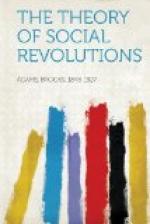The Republican party had full control of the government and was united in vehement support of the laws. On March 21, the second of the two new judges received his commission, and precisely ten days afterward the Attorney-General moved for a rehearing, taunting the Chief Justice with having changed his opinion on this point, and intimating that the issue was in reality political, and not judicial at all.
In the December Term following Knox v. Lee was argued by the Attorney-General, and, on May 1, 1871, judgment was entered reversing Hepburn v. Griswold, both the new judges voting with the former minority, thus creating the necessary majority of one. No one has ever doubted that what General Grant did coincided with the drift of opinion, and that the Republican party supported him without inquiring how he had achieved success.[14] After this it is difficult to suppose that much respect could remain among the American people for the sanctity of judicial political decisions, or that a President, at the head of a popular majority, would incur much odium for intervening to correct them, as a party measure.
The last example of judicial interference which I shall mention was the nullification, in 1895, of a statute of Congress which imposed an income tax. The states have since set this decision aside by constitutional amendment, and I should suppose that few would now dispute that the Court when it so decided made a serious political and social error. As Mr. Justice White pointed out, the judges undertook to deprive the people, in their corporate capacity, of a power conceded to Congress “by universal consensus for one hundred years."[15] These words were used in the first argument, but on the rehearing the present Chief Justice waxed warm in remonstrating against the unfortunate position in which his brethren placed the Court before the nation, protesting with almost passionate earnestness against the reversal by half-a-dozen judges of what had been the universally accepted legal, political, and economic policy of the country solely in order that “invested wealth” might be read “into the constitution” as a favored and protected class of property. Mr. Justice White closed by saying that by this act the Supreme Court had “deprived [the Government] of an inherent attribute of its being."[16] I might go on into endless detail, but I apprehend that these cases, which are the most important which have ever arisen on this issue, suffice for my purpose.[17] I contend that no court can, because of the nature of its being, effectively check a popular majority acting through a coordinate legislative assembly, and I submit that the precedents which I have cited prove this contention. The only result of an attempt and failure is to bring courts of justice into odium or contempt, and, in any event, to make them objects of attack by a dominant social force in order to use them as an instrument, much as Charles II used Jeffreys.




